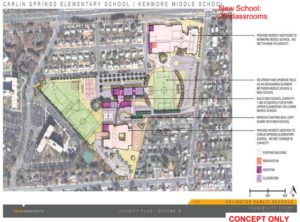 Big changes have been proposed for a number of local schools.
Big changes have been proposed for a number of local schools.
Arlington Public Schools Superintendent Dr. Pat Murphy presented his proposed Capital Improvement Plan (CIP) for Fiscal Years 2013-2022 at a meeting last week. The plan totals nearly $538 million and includes funding for two new elementary schools and additions to three others in order to help address the school system’s capacity issues.
“I believe these changes will enable APS to provide much needed instructional space while continuing to maintain existing facilities that meet the needs of our students and teachers,” Murphy said.
Over the past three fiscal years, APS saw an 18 percent increase in students, which is nearly 3,400 additional students. APS is expected to reach capacity at the elementary school level by next fall.
Five specific capacity-generating construction projects have been identified, and would be funded through current reserves and the 2012 and 2014 bond referenda. Those major projects included in the CIP are:
- A 12-room addition to Ashlawn Elementary School that would be completed in 2014 and would add an additional 225 seats. Funding for this would come from current capital reserves.
- A 12-room addition to Arlington Traditional Elementary School that would be completed in 2014 and would add an additional 225 seats. Funding for this project would be included in the FY 2012 and FY 2014 bond referenda.
- A 12-room addition to McKinley Elementary School that would be completed in 2017 and will add an additional 225 seats. Funding would be split between the FY 2012 and FY 2014 referenda.
- A new elementary school on the Williamsburg Middle School site that would be completed in 2015 and would add 600 seats. $4 million to be used for the design phase would come from current capital reserves.
- A new choice elementary school on the Carlin Springs/Kenmore site that would be completed in 2017 and would add 600 seats.
 The development of these five projects represents the culmination of the “More Seats for More Students” initiative that launched last year. That planning process involved surveys, computer modeling and months of work sessions.
The development of these five projects represents the culmination of the “More Seats for More Students” initiative that launched last year. That planning process involved surveys, computer modeling and months of work sessions.
“The process was structured to be objective, transparent, and result in a set of options driven by School Board determined criteria,” Murphy said. “I am pleased that we met these goals and look forward to deliberating with the Board on this CIP.”
There are “placeholders” included in the CIP to be used for capacity funding in the 2016, 2018 and 2020 referenda. Those funds total $253 million and would likely be used for an additional elementary school, a new middle school and additional space at the secondary school level.
The CIP also includes $34.6 million for HVAC and roofing projects, $21 million for infrastructure projects and $63.4 million for minor construction projects or maintenance.
There will be a public meeting on the CIP on May 24, and the School Board is scheduled to adopt it on June 19.

